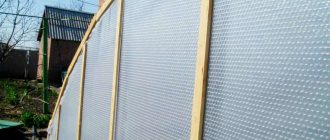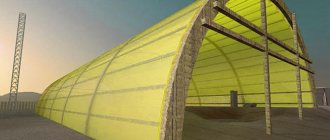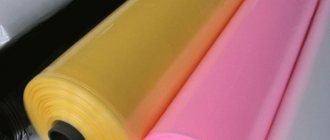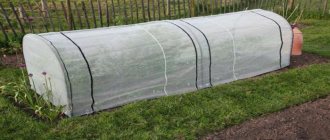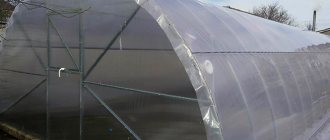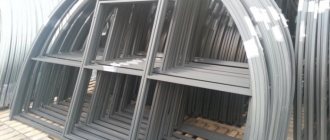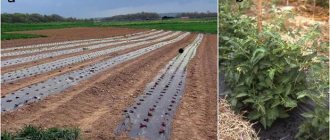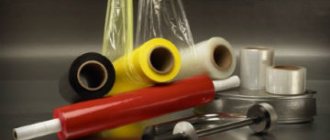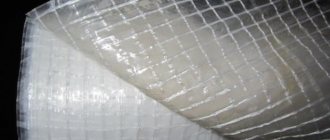Mulching plantings has long been a standard procedure. And although film has been used as a covering material not so long ago, it is clearly the leader among mulching materials, reliably protecting plantings from cold, temperature changes and weeds.
Mulching the soil serves to protect against pests and weeds, retain heat and improve soil composition. Most often, mown grass, bark, ash or straw are used for mulching. But not everyone knows that mulch film is also used for these purposes. It has long been used by gardeners both on small plots of land and on large agricultural lands. What kind of material is this and what is it used for in the country?
What is mulch film
The simplest type of mulching film looks like a solid black polyethylene tape with holes. Through these holes, water, fertilizers and air necessary for life reach the plants. Mulching film accelerates soil warming, retains heat in cold weather and promotes plant growth. Most often it is used in beds with vegetables, strawberries and wild strawberries, and beds are covered with it mainly in spring and autumn .
Mulching film prevents the rapid evaporation of moisture from the soil and improves the microclimate in the planting area
The most popular types of shelters
- Spunbond allows air, light, and UV rays to pass through. Protects against pests, birds, and creates a certain microclimate.
- Agrofabric is used mainly for weed control in open ground, in greenhouses and hotbeds, allowing you to avoid the use of herbicides and obtain environmentally friendly products. Creates optimal temperature under cover. Comes in different colors.
- Shade nets help protect plants planted in open ground from direct ultraviolet rays;
- Light-stabilized film with a UV ray stabilizer retains heat well, retains moisture, and prevents the leaching of fertilizers from the soil;
- Reinforced film is often used to cover greenhouses and has increased resistance to mechanical damage. The film contains UV stabilizers that evenly scatter the sun's rays and extend its service life.
Types of mulching film
Most often, mulch film refers to two types of covering material: actual waterproof polyethylene films and agrofibre (non-woven water-permeable material). In this article, we are more interested in films that differ according to several criteria:
- in thickness - films with a thickness of 30 microns or more are suitable for mulching. Thin films can also be used, but they are usually enough for no more than one season. For long-term use, it is better to choose films with a thickness of 30 to 60 microns;
- by color - mulching films can be of different colors: transparent, black and two-color (black on the bottom and white/red/orange/silver on top). Most often, in areas located in a temperate climate zone, a solid black film is used - weeds do not grow under it and heat is retained well. For hotter regions, it is recommended to choose a film with a black backing and a light surface. And films of bright colors are believed to disorient pests and discourage them from the site.
Mulching with wide strips of film increases the temperature of the soil and root system faster
Film cover for beds
Colored film cover
The film has a wide range of applications, is inexpensive, has good light transmittance, and protects crops from frost and weeds. Unlike non-woven material, it does not allow water or air to pass through it. Without additional ventilation, this can lead to the appearance of fungus and mold. At the same time, in a greenhouse, polyethylene retains much more heat and protects well from wind and hail.
Manufacturers add stabilizers to ordinary cellophane, which impart certain qualities and slow down the decomposition process. Such materials have a certain color, indicating the type of film:
- The blue tint shows UV resistance and hydrophilic qualities. Special components in the composition prevent drops of condensation from forming, moisture flows down the inner surface in streams.
- Green tint – increased heat-saving properties. Maintains temperature at night 5 degrees more than regular film.
- Transparent film labeled EVA (ethylene vinyl acetate) has a long service life, 5–10 years. It feels rubbery to the touch and has good light transmission qualities. Thanks to its strength and elasticity, it can withstand severe frosts.
- The reddish or orange hue is used to convert ultraviolet radiation into infrared. Helps accelerate plant growth.
Be careful, plastic film has a ray scattering coefficient. For southern regions, protection against excess lighting is used - a high coefficient is chosen. In northern latitudes, low coefficient coverage is used to provide plants with sufficient light.
Reinforced film shelter
Reinforced film cover
The inside of the film is reinforced with mesh, used for covering greenhouses and greenhouse frames. Does not stretch, does not deform, and is resistant to various mechanical influences. Withstands aggressive atmospheric conditions for a long time and has UV protection. The service life depends on compliance with the fastening technology, and is 3–5 years.
Film with air bubbles
Bubble film
Thanks to the air bags on the film, reliable protection against hypothermia is provided. Greenhouses and greenhouses are covered with canvas during periods of severe frost. Remove immediately after the cold weather has subsided so that excess moisture does not accumulate inside. The material is presented in two types:
- Two-layer - air bubbles are fixed on top of the polyethylene film. It is used as insulation, as packaging, insulating protection for fragile objects.
- Three-layer - a bubble layer is fixed on the surface of the polyethylene film, and above it a layer of flat film. Has increased strength and density. Used as a covering material for greenhouses, for uniform light distribution and maximum thermal insulation.
Double-sided polyethylene
Double-sided polyethylene
Black and white polyethylene gives a double effect. White color reflects the sun's rays, while black color absorbs it. Their combination in a film is used as mulch for plants and to accelerate fruit ripening. The dark side is laid on the surface of the earth to prevent the appearance of weeds and prevent moisture from evaporating. The light surface promotes active photosynthesis for crop vegetation.
How to mulch strawberries with film
Planting strawberries under film is one of the most popular methods of growing this crop in the middle zone. The fact is that film has a number of advantages:
- accelerates soil warming;
- maintains a constant soil temperature;
- inhibits the growth and development of weeds;
- protects plants from gray rot.
The edges of the mulching material are fixed in furrows with a depth of at least 10 cm located along the perimeter of the bed.
However, in order to achieve a good harvest of berries, when planting strawberries under film, you need to follow clear rules. Many novice gardeners neglect them and make a number of mistakes, and then refuse to use film material due to the fact that it allegedly did not live up to expectations. So, how to mulch strawberries correctly in order to get the maximum effect from using the film:
- in the spring, get ready to plant strawberries - dig up the soil, add compost and fertilizer to it, remove clods of soil and weed roots;
- water the beds;
- then cover the soil with mulch film and sprinkle its edges with earth;
- at the required distance, make round slits with a diameter of 8-10 cm or cross-shaped cuts in the film;
- plant the prepared strawberry seedlings in these holes.
Polymer film should only be used on formed beds. If you simply cover the ground with it, water will accumulate in microdepressions, and individual bushes will begin to rot, and other plants will not have enough moisture. Therefore, only flat and high beds should be covered with film, and the film itself needs to be pulled tightly and deflections eliminated.
Types of polyethylene film
There are several types of polyethylene film. In some cases, it is economically feasible to use this material rather than agrofibre. The film can last longer, and in some respects it is superior to non-woven materials. In addition to regular polyethylene film, there are also improved varieties.
Reinforced polyethylene
This film is made by combining two or three layers with a reinforcing mesh placed between them. Some models are distinguished by the addition of UV stabilizers that prevent the destruction of polyethylene by sunlight.
Scope of application of reinforced polyethylene:
- for unheated greenhouses;
- for heated greenhouses;
- for greenhouses of different heights.
The strength of reinforced polyethylene film is such that the material can easily withstand hail and strong winds. In the southern latitudes of the country, the film lasts for 3 years, in the conditions of central Russia and further north - up to 5 years.
You can extend the life of this covering material if you remove it for the winter and put it away for storage.
Film with light stabilizer
Light-stabilized polyethylene is used in greenhouses located in regions with a lot of sunny days. This material is obtained by adding special additives that increase resistance to ultraviolet radiation.
Dyes can be added to light-stabilized polyethylene. Thus, orange film is used on farms to accelerate fruiting - it provides the necessary spectrum of light to plants.
Double layer film
This covering material has two layers of different colors - black and white. It is used exclusively for mulching beds, for which the film is laid with the black side down.
A two-layer film prevents the soil from overheating, but does not allow it to be properly moistened and does not allow air to pass through. Therefore, its scope of application is limited.
Cover the potatoes with film
You can plant potatoes in the spring immediately under the film. This will eliminate many of the problems associated with growing this crop and will allow you to get the harvest 3-4 weeks earlier, because:
- the soil under the film warms up faster;
- plant development phases are accelerated and seedlings appear earlier;
- the root system develops very actively, and the tubers are not afraid of frost;
- there is no need for weeding since there are no weeds.
The only drawback of the film covering method is the high cost of the covering material.
To form a bed of potatoes hidden under a film, you need to choose a plot of land oriented to the south, which dries out earlier than the rest in the spring and is protected from strong winds.
Mulching potatoes with film is a fairly popular agricultural technique. Using film, the crop is grown on ridges or in ridges, so when planting, the tubers are not buried, but laid out on the surface of the soil. The aerial part grows through special holes in the film. New tubers also grow on the surface, and to harvest you only need to lift the film. The advantages of this growing method are that the potatoes do not need to be hilled, since light does not penetrate through the impermeable film. It also prevents the germination of weeds and retains moisture in the ground. Plants mulched with film require less organic matter and fertilizers.
Color
Participant kler26 writes the following: “Has anyone used black agrofibre to cover the ground in garden beds to prevent weeds? I had some trouble with him. Maybe I'm doing it wrong. I only water each hole; the water washes away the soil, leaving bare roots. That's why I add soil regularly. The weed also grows under the fiber. you have to stick your hand in and somehow pull them out - it’s very inconvenient. In addition, the fiber periodically pokes out from under the ground, so you have to crawl and cover it with new ones. I thought it would be easier with him, but something turns out to be more troublesome.”
The canvases differ in color, which is also chosen in accordance with the area of application. They are suitable for the following purposes:
- Black. Used in cold regions. They attract sunlight, so the soil warms up faster. Even before planting the plants, the beds are lined with material. After 1-1.5 weeks, the soil becomes suitable for sowing.
- White. Reflects light, preventing weeds from developing. Slots are made in the canvas for plants. Shoots located above the material receive more light.
- Black and white. The canvases are white on one side and black on the other. They are spread directly onto the beds. The black side faces down. This prevents grass from growing. The white side reflects the sun's rays, preventing overheating of the soil and plants. The material is used for vegetable gardens in warm climates. You will need to water and weed the beds less often.
- Green. It is used for near-trunk decoration and for mulching the soil. Creates a beautiful landscape near the house and prevents the germination of weeds.
How to grow tomatoes under film
Mulching with film of tomatoes is increasingly used when growing this crop indoors. The film reduces the level of air humidity and improves the microclimate in the greenhouse, so tomatoes are less likely to suffer from late blight and other diseases and are less susceptible to rot. Weeds do not grow through impermeable covering material, and the soil remains moist longer. The only drawback of this mulching is that the film does not help fertilize the soil, so before covering the plants you need to feed them generously.
To grow tomatoes, it is important to use the “right” color of film. Transparent is not suitable for tomato bushes, since enough light penetrates through it for weed growth. The black film actively condenses moisture and “dumps” it back into the soil, which favors the growth and fruiting of tomatoes. Opaque red film looks more attractive.
Growing tomatoes under mulch film is very easy:
- A few days before planting the seedlings, spread them out on the garden bed and sprinkle the edges with soil;
- make round or cross-shaped holes in the right places and plant tomato seedlings;
- Take care of the plants in the same way as usual - water at the roots, apply fertilizers and treat against diseases and pests.
In cold climates, the use of film is effective as it retains the heat of the earth. But when it gets hot, black polyethylene must be sprinkled with straw or other similar material to prevent overheating of the soil.
If it gets very cold, you can lay another layer of film on top of the first one.
How to choose covering material?
Covering non-woven material of SPUNBOND type”
Choosing covering material for beds is not an easy task. In general, the choice depends on the following factors:
- Cultivated crop and planned harvest date
- Climate of the area
- Type of soil and its features
- Presence of weeds, diseases and pests in the growing area
If you grow early varieties in cold and windy climates, then it is best to use reinforced or bubble film as a covering material for the greenhouse. In case of strong winds - polycarbonate. Products made from ordinary polyethylene will be useless in this case.
Hydrophilic film has proven itself well for growing nightshade or pumpkin crops. Berry crops in greenhouses should be grown under polyethylene with phosphor additives.
Bed under cover
For growing in a relatively warm climate, but with changing weather conditions or strong winds, it is correct to choose elastic film as a covering material for a greenhouse.
And so on and so forth. As a rule, each material in the description already contains information in what conditions and for what crops it should be used.
The criteria for choosing nonwoven materials or agrofibers are similar - it all depends on the plant being grown and the conditions of detention. For example, you should not use dark agrofibre to mulch the surface in hot climates, as this will lead to overheating of the soil and, as a consequence, the root system.
There is also no need to use agrofibres to wrap bushes for the winter - non-woven materials were created for these purposes, because they have lower thermal conductivity and allow cold air to pass through much worse.
VIDEO: Covering material for beds, features and differences
Covering material for beds, features and differences
Covering material for beds | TOP 14 Main types: their general characteristics, how to choose? | (Photo & Video) + Reviews
Growing cucumbers under film
Film for growing cucumbers has long become one of the mandatory attributes of a successful gardener. The main advantage of the film growing method is that in this case the plants are protected from temperature changes .
When mulching cucumbers with film, follow our tips:
- in April, prepare a nutrient mixture of 1 part compost, peat and sawdust and 2 parts turf soil;
- organize ridges 80 cm wide and passages between them 60 cm wide;
- add mineral fertilizers to the soil: 1 tsp. urea and 2 tbsp. double superphosphate per 1 sq.m. After this, dig the bed to a depth of 25 cm, and on the eve of planting, spill it with warm water at a temperature of up to 50°C, spending 5-6 liters per 1 sq.m;
- cover the bed with black perforated film, cover the ends with earth;
- Make cross-shaped holes in the film and sow cucumber seeds in them or plant grown seedlings.
In hot weather, the film can become very hot. In this case, water it with water in which chalk is diluted.
To grow cucumbers, you can build a mini-greenhouse with a mulch layer and a film cover installed on the frame
Arrangement of paths using agrofibre
Mulching covering material helps in arranging garden paths. It can be film or agrofibre, but must be black. It is best to use non-woven material due to its water permeability. Puddles will never accumulate on the garden path after rain.
To make a path or create a decorative circle around a tree trunk, you need to dig a ditch as deep as a spade bayonet. The bottom is covered with black agrofibre, and the top is covered with crushed stone, pebbles or other decorative stone. There will be no weeds or puddles in this area.
Peppers under film
Growing peppers under a film is done by those summer residents who do not want to waste time on frequent weeding and watering. Peppers are grown quite successfully under film cover, but there are some features that should be taken into account:
- In autumn, the necessary fertilizers are added to the soil: humus or compost - at a rate of 4 to 15 kg/sq.m, superphosphate (80-100 g/sq.m) and potassium chloride (15-25 g/sq.m). If the soil is heavy, add peat (15-25 g/sq.m.), rotted sawdust (1 bucket per 1 sq.m.) or sand (4-5 buckets per 1 sq.m.).
- a few days before planting the seedlings, the soil in the garden bed is leveled, loosened and covered with straw, hay or sawdust with a layer of 3-5 cm. A mulching film is laid on top of this;
- When planting seedlings, cross-shaped cuts are made in the film at a distance of 20-30 cm from one another. Leave 30-40 cm between the rows. Plants are planted in holes, covered with soil and watered abundantly.
Pepper grows well at a relative soil humidity of no more than 75-80%
Mulching film is used to protect garden crops from aggressive environmental conditions. It has a number of advantages and is actively used to maintain heat and control weeds. If you haven't used this covering material yet, be sure to try it.
General characteristics of covering materials
Planting strawberries on black spunbond
A wide variety of materials can be used as a means to protect plantings. Moreover, each of them is based on some substance. Despite the abundance of various means of protection, they are all based on several chemical compounds that are polymers:
- polyethylene
- nylon
- acrylic
- polycarbonate
Some of the substances are used in their natural form (for example, polyethylene), others are part of rather complex structures. For example, a non-woven covering material can consist of almost any polymer.
Greenhouse film
In general, covering materials are divided into 4 large groups:
- polyethylene films
- non-woven polymer fabrics
- agrofabrics
- hard covering material (polycarbonate, polystyrene foam)
- various shading nets
Below we will consider what types of covering materials there are, their properties and applications are described. Recommendations on the selection of materials and useful tips for their operation will also be presented.
No. 1 Polyethylene film
Polyethylene film
Polyethylene film Polyethylene is one of the most popular polymers at present. Various light-heat- and moisture-insulating coatings are made from it, so this material simply could not help but fall into agriculture, both private and industrial. From a chemical point of view, it is the simplest polymer formed by a standard hydrocarbon group.
However, it is chemically resistant and has the following advantages:
- does not interact with water (insoluble in it, has very low adhesion, does not wet)
- not sensitive to shocks
- does not react with any alkalis and acid salts
- withstands temperatures up to +80°C without deformation
The popularity of polyethylene has not lost its significance almost a hundred years since its invention. Moreover, for the needs of private or industrial cultivation of various crops, in some matters this polymer is literally irreplaceable. The main methods of using coatings made from this polymer are discussed below. They are distinguished not only by the thickness and color of the film, but also by other parameters (elasticity, thermal conductivity, resistance to ultraviolet radiation, etc.)
The service life of polyethylene film is from 3 to 5 years. Over time, it loses its properties and requires replacement.
Traditionally, plastic film is used by summer residents to cover greenhouses and greenhouses for growing vegetables (cucumbers, tomatoes, pumpkins, etc.) in the garden. Usually, in such cases, the greenhouse is not stationary, but is a temporary frame structure, which is covered with plastic film.
You can generally cover the beds at your summer cottage with a simple structure consisting of steel arches with simple fasteners over which the film will be stretched. This installation method is very convenient because it is relatively simple, cheap and fast. Such a shelter will not last long, but the speed of its production and low cost justifies the short service life.
Depending on various parameters, one or another type of shelter is selected. These options include:
- thickness
- color
- UV resistance
- elasticity
The disadvantages of polyethylene film include its fragility and vulnerability to strong physical influences (for example, gusts of wind or hail). In this case, to create garden shelters, it is recommended to choose and buy a different type of covering material.
No. 2 Elastic film
Elastic film
Elastic film Ordinary polyethylene does not stretch very well under the influence of external factors and weather conditions (wind, precipitation, etc.), so greenhouses often become unusable due to breaks or sagging of the covering material.
In order to solve this problem, elastic films made of ethyl vinyl acetate are used. Their properties are similar to those of polyethylene, but they have greater elasticity and the ability to restore their original shape, like rubber, which extends the service life of the greenhouse.
Such greenhouse shelters have proven themselves best in open areas with strong winds.
No. 3 Thermal insulating film
Thermal insulating film
Thermal insulating film By adding special substances to polyethylene, materials with good thermal insulating properties are obtained. Outwardly, they resemble ordinary polyethylene, but, as a rule, its color will be slightly different due to additives (most often greenish or matte). Thanks to their chemical composition, such shelters are able to keep the temperature inside the shelter several degrees higher than outside.
The greenhouse effect created by such materials is more pronounced, which can have its negative sides in hot weather. To avoid overheating of crops in hot weather, it is recommended to regularly ventilate the greenhouse by covering it with insulating film.
No. 4 Hydrophilic film
Hydrophilic film
Hydrophilic film On ordinary plastic film, condensation accumulates from evaporation, which then drips down onto the plants, which is not always good. A special film of a bluish or greenish tint can cope with this problem.
The main feature of this material is that water does not drip from it, but flows along bending lines, which prevents it from getting on the plants, which contributes to fewer plant diseases. In addition, due to their composition, such materials protect crops well from ultraviolet radiation.
Mostly pumpkin or nightshade crops are planted in such greenhouses.
No. 5 Polyethylene with phosphor additives
Polyethylene with phosphor additives
Polyethylene with phosphor additives This film can be of different colors: yellow, pink, orange, etc. And the point here is not in aesthetics, but in the special polarizing properties of the material. Thanks to special additives, such a material is able to transmit only part of the radiation, blocking those parts of the spectrum that would be harmful to the crop.
Depending on the color, such covering materials transmit, for example, only infrared radiation, completely blocking ultraviolet radiation. Or, they only transmit visible light from red to yellow, etc.
In any case, all films with phosphor additives block from 50 to 99% of ultraviolet radiation.
No. 6 Black polyethylene film
Black polyethylene film
Black polyethylene film Mainly used as a replacement for mulching material. It is laid on the ground, so that almost all the moisture under the plants does not evaporate, but remains in the ground. This allows you to reduce the number of waterings.
In addition, dense dark polyethylene retains solar heat and prevents pests from getting to the root system of plants.
No. 7 Reinforced greenhouse film
Reinforced greenhouse film
Reinforced greenhouse film Polyethylene or polyacetate film, which is applied to a durable nylon frame or a thicker layer of polyethylene. It is practically not elastic, but this is not necessary. The strength and durability of this material is significantly higher than that of any other film type.
If you cover a greenhouse with similar material, the plants in it will not only be insulated from rain and cold, but will also receive protection from hail. This film is also ideal for protecting crops from the wind.
Most often, it is a three-layer structure, in which the reinforcing frame is located between two layers of polyethylene. At the same time, various additional components can be added to it, and it can repeat the functionality of all previously considered films.
Reinforced film with holes, dark colors, different polarization coefficients, etc. is also produced. The range of such covering material is huge and can be considered almost universal. But it should be understood that the cost of such material will be 2-3 times higher than the cost of conventional film, but its service life will also be longer.
No. 8 Bubble film
Bubble wrap
Bubble film Its structure is similar to the reinforced film discussed earlier, but in the intermediate layer there is not a frame, but foamed air bubbles. Thanks to the presence of this layer, the thermal insulating properties of such a film are significantly increased while maintaining lightness.
At the same time, its structure will be no less strong than that of a reinforced one - the function of the frame is taken over by numerous bubble walls. It can also have different colors.
A significant disadvantage of bubble film is low transparency. This should be taken into account when using it to cover light-loving crops.
No. 9 Non-woven covering material
Non-woven covering material
Non-woven covering material There are a large number of materials made before this technology. From the gardener’s point of view, they are all practically the same and have a similar purpose.
Very often the term “spunbond” is used to name this category of materials. This word does not mean the material itself, but the technology of its production. Regardless of the type of raw material used, the covering fabric is obtained from molten polymer using the spunbond method (threads of the material are obtained by pressing the molten polymer through small holes). The covering material itself, depending on the manufacturing technology or country of origin, can be called differently: lutrasil, agril, novagril, agrin, agrotex, etc.
The polymers used in the production of spunbond can be, for example, polyethylene, PVC or polypropylene. Depending on the density, spunbond can be used as a heat insulator (up to 100 g per 1 sq. m) or as agrofibre (density 200-300 g per sq. m). Spunbond is non-toxic and chemically neutral.
Thanks to its membrane properties, it can be used as a “breathable” material that allows moisture to pass through in one direction. Also, depending on the production technology, it can be used as a heat insulator, or as a covering material that does not allow water to pass through, but allows air exchange.
There are many manufacturers of this material on the market, so gardeners always have a choice. One could even say more: choosing a covering material is quite problematic, since the production technology is approximately the same and there is not much difference depending on the country of origin.
Well-known foreign manufacturers of covering materials:
- Freudenberg (Germany) – Lutrasil brand
- Covertan & Novagryl (France) – Agryl trademark
- Dupont (France) – Plantex trademark
- Chongqing (China)
Russian manufacturers:
- Agrosetka-South
- Agrotex
- Technoexport and so on.
As a standard, spunbond is sold to customers in rolls. Their width can vary widely (from 4 to 600 cm). At the same time, the material can be easily cut with any tools.
No. 10 White spunbond
White spunbond
White spunbond There are several density standards for such materials. Typically, the density of light (or white) spunbond fabrics is relatively low. Ini are mainly used for short-term shelters or as thermal insulation.
White spunbond is available in the following densities:
- up to 30 g per sq. m
- 42-60 g per sq. m
- 60+ g per sq. m
Each of them is used for its own tasks. Thus, the first, lightest material is used to protect against short return frosts, cold snaps, and temperature changes. These agricultural materials are also intended for covering low-growing garden crops and seedlings in open ground and for wrapping trees and bushes.
Denser material is used for the construction of greenhouses, for wrapping heat-loving crops and for protecting them from frost.
The densest material is used to create stationary greenhouses, which are planned to be used for several seasons. Naturally, when designing them, one should remember the low transparency of the material; It is mainly used in the lower sections of walls.
The white color of the material allows you to reflect most solar radiation and is used for:
- shading young plants from the scorching sun
- creating a microclimate for low-growing crops (of course, only for those that do not need pollination)
- protection of crops from birds and insects
- creating temporary shelters for seedlings or newly planted seeds
- for winter shelter of crops from frost
No. 11 Black non-woven material
Black non-woven fabric
Black non-woven material Unlike white, which is traditionally located above the plants, this type of material is laid underneath them - on the ground. In fact, it is a kind of mulch substitute. It has low permeability to moisture, as it is designed to hold it in the soil and prevent it from evaporating. In some ways its functions are similar to the black polyethylene film discussed earlier.
The soil under such material remains moist for a long time, in addition, it creates an insurmountable obstacle to most pests and weeds. At the same time, unlike polyethylene film, non-woven covering material perfectly allows air to pass through.
In fact, caring for crops using such material is greatly simplified - the gardener does not need to weed and loosen the soil. In addition, it is much more durable than any type of mulch. This material does not absorb moisture (some types even repel it), so crops mulched with such coatings should be watered exclusively under the bush.
For any artificial mulching, it is correct to use drip irrigation.
No. 12 Multilayer nonwoven materials
Multilayer nonwovens
Multilayer nonwoven materials There are many varieties of multilayer covering materials. Since they consist of several layers, they, as a result, combine the same number of functions.
For example, a three-layer “pie” made of white material on top, black below and a heat-insulating layer between them allows you to solve several problems at once:
- perform the function of mulching, saving moisture and preventing pests from penetrating into the soil
- provide thermal insulation of the top layer of soil to protect the root system from frost
- thanks to a light or even reflective top layer (as a rule, foil coatings are used), reflect part of the solar radiation that hits the ground back to the plant, thereby accelerating the processes of photosynthesis and crop ripening in it
No. 13 Agrofabric
Agrofabric
Agrofabrics are essentially fabrics made from polymers. Their functions are similar to non-woven covering materials, but are stronger and more durable. They also come in different colors and can consist of several layers.
In addition, high-density spunbond can be sold under this name, which, although it is a non-woven material, is close in its properties to agrofabrics. Typically, the term “agrotextile” is used for it. It is difficult to say for sure which covering material should be used, since they are very similar. Spunbond, although less durable, is lighter, with approximately similar other characteristics.
These materials cover the soil and act as artificial mulch. Their advantages over natural mulching methods include better isolation of the soil from the penetration of pests. They almost completely stop the growth of weeds.
In addition, agrofabrics create an optimal microclimate in the surface layer, thereby increasing the retention of moisture in the upper layer of soil. An additional effect from the use of agrofabrics is that the soil surface is reliably protected from temperature changes while maintaining air exchange.
There is another important advantage of this material, which significantly increases the yield of some crops (for example, berries - strawberries, wild strawberries, etc.) Ripe berries, if they fall on the ground, will not come into contact with the ground, but with chemically neutral agrofibre. Thanks to this, the crop will be protected from rotting.
No. 14 Polycarbonate
Polycarbonate
Polycarbonate A hard and durable material used to construct greenhouses. Unlike glass, it is lighter, but much less fragile. It can be easily processed with tools, which allows you to build greenhouses of any complexity yourself.
Cellular polycarbonate has a high degree of transparency. Thanks to various additives, polyethylene film can be used to polarize light, which allows it to protect plants from ultraviolet radiation.
It can have different thicknesses, as well as a porous or corrugated structure, which achieves its excellent heat-insulating properties. A polycarbonate greenhouse can be easily disassembled at the end of the season for winter storage and reinstalled in the spring.
Black agrofibre or two-tone material?
Amateur gardeners, as well as farmers who grow fruits and vegetables on a large scale, are freed from the need to purchase and use herbicides against weeds. They also don’t have to spend time at their summer cottages with hoes, spending a lot of physical effort and time on weeding. There are simply no weeds. Only useful crops grow in even rows.
In addition, the fruits remain clean after rains, since they do not come into contact with the ground. Strawberries grown on beds covered with agrofibre can be harvested immediately after rain. The berries lie on a dry cloth and have an excellent presentation. They can be served on the table, lightly rinsed from dust, or taken to the market for sale. Using black mulching agrofibre, you can achieve earlier ripening of the crop. It is possible to reduce the growing time of crops to two weeks by early warming up the soil under cover.
The use of mulching agrofibre eliminates a large amount of work on caring for plantings in the garden, since there is no need to weed the beds
An interesting new product has appeared in the range of covering materials - two-color mulching agrofibre, which is superior in functionality to conventional black canvases. The manufacturer has improved the product by combining two thin layers of white and black. As a result, the covering material is black on one side and white on the other. The dark side of the canvas is laid on the ground, and the light surface is on top and reflects sunlight that falls on plants and fruits from below, accelerating their growth and ripening.
Important! The white surface of the mulching two-color agrofibre prevents the root system from overheating, which affects the growth rate of crops grown on the site and the uniformity of fruit ripening.
